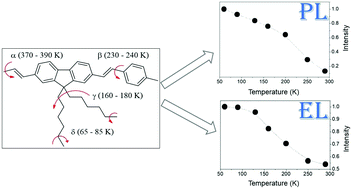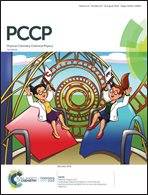Temperature effect on the electron–vibrational mode coupling of a fully conjugated polyfluorene derivative†
Abstract
Photoluminescence (PL) and electroluminescence (EL) spectra were used to probe the thermal relaxation processes of the poly(9,9′-n-dihexyl-2,7-fluorenediiylvinylene-alt-1,4-phenylenevinylene) (LaPPS16) electroluminescent polymer. A theoretical model of molecular excitons and Franck–Condon transitions were used to analyze the line shape of the radiative transitions. It was possible to correlate directly the electron–vibrational mode coupling, i.e., the Huang–Rhys parameter, and the polymer relaxation processes due to the effects of molecular dynamics on the electronic states. The results showed different dependences of the thermal relaxation process on PL and on EL due to the molecular dynamics restraints of LaPPS16. This could explain the efficiency variation in organic light emitting diodes where the external electric field would decrease the degrees of freedom of the polymer and activate specific non-radiative channels. Molecular relaxation temperatures of the LaPPS16 polymer are proposed.



 Please wait while we load your content...
Please wait while we load your content...